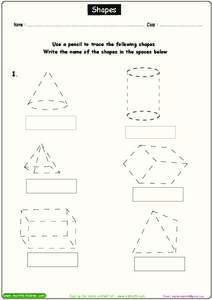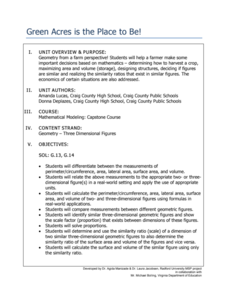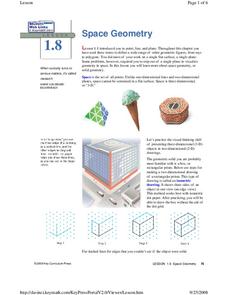Scholastic
Study Jams! Edges, Faces, Vertices
Before determining the classification of a three-dimensional shape, you need to know about the characteristics of a vertex, edge, and face. Go step-by-step using a prism, and discover what each aspect refers to and how it applies to...
Curated OER
Shape Hunt
Students explore two-dimensional and solid shapes. In this shapes and patterns geometry activity, students work with a partner to create identifiable objects using tangrams. Students describe the attributes of their shape and their...
Curated OER
Investigating Shapes in Our World
First graders explore shapes. For this geometry lesson, 1st graders make shapes with geo-boards, use play-dough to make three-dimensional figures, and make a shape book using pre-cut shapes.
Curated OER
Using the Web to Explore Shapes
Third graders research the Internet to locate geometric designs in familiar buildings. They review shapes, solids, angles and symmetry as they research websites of familiar buildings in Louisville. They record the information they see...
Curated OER
Identify Cones
Third graders evaluate the attributes of cones. In this space shapes instructional activity, 3rd graders analyze three-dimensional shapes. Students explore the faces and edges of a cone.
Curated OER
Compare 2-D Shapes
Second graders examine the attributes of two-dimensional shapes. In this geometry lesson, 2nd graders play a game in order to identify two-dimensional shapes and to name them.
Curated OER
Geometric Patterns
Geometric patterns illuminate this colorful and interactive PowerPoint. First, patterns must be identified. Next, students discern the missing color in a block pattern. Lastly, they observe a figure to determine how many blocks are used....
Curated OER
Making Two-Dimensional Shapes
Find the shapes that fit. Pupils explore visual discrimination in a set of geometry worksheets, which has them examine shapes that have been divided in half. They observe a set of shapes to determine which of them would fit into each...
Curated OER
Making Two-Dimensional Shapes
Which shapes fit? Learners practice visual discrimination using a geometry worksheet, which has them examine shapes that have been divided in half. They observe a set of shapes to determine which of them would fit into each half of the...
Curated OER
Geometry, Shapes and Public Sculpture
Students explore characteristics of geometric shapes. They observe geometric shapes and forms in public sculpture. Students create a unique sculpture of their own using basic three dimensional shapes. Additional cross curriculum...
Curated OER
Nets and 3 Dimensional Figures
In this nets and 3 dimensional figures activity, 5th graders look at the 3D figure and the net and mark yes or no if it is an accurate representation.
Curated OER
Shapes
In this shapes activity, students trace each of the 3D shapes and then write the name for the shape. Students complete 6 problems.
Curated OER
Shapes Galore!
First graders create two-dimensional shapes. In this shapes lesson plan, 1st graders learn about different two-dimensional shapes. Students have many hands-on experiences with these shapes including the use of geoboards, shaving cream,...
Curated OER
Edible Geometry
Learners examine a chart that lists the main characteristics of polygons and 3 dimensional figures. They make examples of the polygons and figures using pretzels and gum drops showing how the gum drops are vertices and the pretzels are...
Curated OER
Shapes
Students identify attributes of different geometric shapes. In this geometry lesson, students view a PowerPoint presentation on shapes and use attribute blocks to examine the corners and edges of each shape. Students work together...
Curated OER
Area of 2D Shapes Homework
In this geometry worksheet, students solve the area of 2D shapes starting with squares, rectangles, parallelograms, triangles, rhombi, trapezoids, circles, and ending with area of shaded regions. There are 20 questions.
Curated OER
Making Two-Dimensional Shapes
Use this introductory geometry worksheet as a projected warm-up for your class, doing it together and then revealing the explanation on the bottom half. Learners examine a square and a circle, each bisected by a dotted line. They must...
Curated OER
Properties of Polygons, Parallel Sides, and Right Angles
Have fun with shapes! Third graders read a set of instructions and circle the shape in the description. They work on recognizing parallel sides and right sides. Use this resource as homework after your geometry lesson.
Curated OER
Spotting Polygons
See all sides of the story with a worksheet on geometric shapes! After studying the example at the top, which matches polygons with solid figures, second graders circle shapes that are named in the directions. Next, they match polygons...
Science Geek
VSEPR and Molecular Geometry
Many chemistry jokes have no reaction. Presentation begins by explaining what models are and the limitations of various forms before introducing the VSEPR model. Then it outlines the rules for creating a VSEPR model and shows examples of...
Radford University
Fun with Solids
Geometry is all around us—if we're only willing to look. The final three activities of the Fun with Solids unit continue work on surface area and volume. For lesson three, scholars investigate the formulas for spheres and solve a problem...
Radford University
Green Acres is the Place to Be!
Nurture a love of math and farming at the same time. Pupils apply geometry concepts, such as surface area and volume of three-dimensional shapes and similarity ratios, to farming contexts. They consider the dimensions of bales of hay,...
Curated OER
Angles - Unlocking Geometry
Students investigate the concept of angles and how they are used in geometry. They construct polygons using various types of angles and then classify them according to their physical properties. Students use a computer program in order...
Curated OER
Space Geometry
Students explore points, lines and planes as it relates to geometry. In this geometry lesson, students analyze space and explain wy it is 3-D and not flat or 2-D. They solve problems involving volume and 3-D shapes.

























